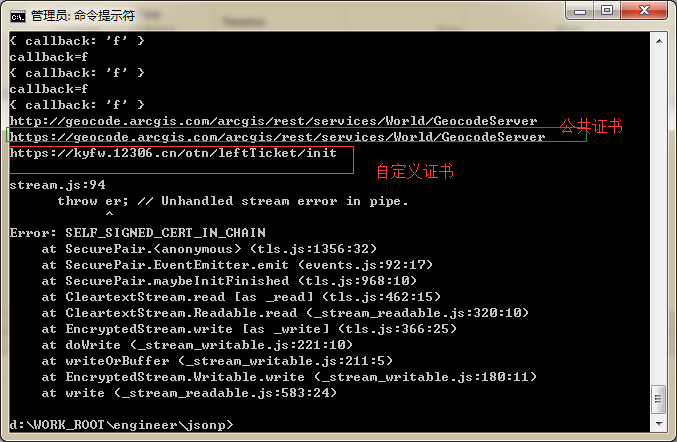探讨跨域请求资源的几种方式(总结)
发布于 2017-07-22 02:53:37 | 117 次阅读 | 评论: 0 | 来源: 网友投递
这里有新鲜出炉的Javascript教程,程序狗速度看过来!
JavaScript客户端脚本语言
Javascript 是一种由Netscape的LiveScript发展而来的原型化继承的基于对象的动态类型的区分大小写的客户端脚本语言,主要目的是为了解决服务器端语言,比如Perl,遗留的速度问题,为客户提供更流畅的浏览效果。
这篇文章主要介绍了探讨跨域请求资源的几种方式(总结),小编觉得挺不错的,现在分享给大家,也给大家做个参考。一起跟随小编过来看看吧
跨域请求资源的几种方式,具体如下:
1.什么是跨域
2.JSONP
3.proxy代理
4.cors
5.xdr
由于浏览器同源策略,凡是发送请求url的协议、域名、端口三者之间任意一与当前页面地址不同即为跨域。具体可以查看下表

JSONP
这种方式主要是通过动态插入一个script标签。浏览器对script的资源引用没有同源限制,同时资源加载到页面后会立即执行(没有阻塞的情况下)。
<script>
var _script = document.createElement('script');
_script.type = "text/javascript";
_script.src = "http://localhost:8888/jsonp?callback=f";
document.head.appendChild(_script);
</script>实际项目中JSONP通常用来获取json格式数据,这时前后端通常约定一个参数callback,该参数的值,就是处理返回数据的函数名称。
<!doctype html>
<html>
<head>
<meta charset="utf-8">
<meta name="viewport" content="initial-scale=1, maximum-scale=1,user-scalable=no">
<title>jsonp_test</title>
<script>
var f = function(data){
alert(data.name);
}
/*var xhr = new XMLHttpRequest();
xhr.onload = function(){
alert(xhr.responseText);
};
xhr.open('POST', 'http://localhost:8888/cors', true);
xhr.setRequestHeader("Content-Type", "application/x-www-form-urlencoded");
xhr.send("f=json");*/
</script>
<script>
var _script = document.createElement('script');
_script.type = "text/javascript";
_script.src = "http://localhost:8888/jsonp?callback=f";
document.head.appendChild(_script);
</script>
</head>
var query = _url.query;
console.log(query);
var params = qs.parse(query);
console.log(params);
var f = "";
f = params.callback;
res.writeHead(200, {"Content-Type": "text/javascript"});
res.write(f + "({name:'hello world'})");
res.end();

缺点:
1、这种方式无法发送post请求(这里)
2、另外要确定jsonp的请求是否失败并不容易,大多数框架的实现都是结合超时时间来判定。
Proxy代理
这种方式首先将请求发送给后台服务器,通过服务器来发送请求,然后将请求的结果传递给前端。
<!doctype html>
<html>
<head>
<meta charset="utf-8">
<meta name="viewport" content="initial-scale=1, maximum-scale=1,user-scalable=no">
<title>proxy_test</title>
<script>
var f = function(data){
alert(data.name);
}
var xhr = new XMLHttpRequest();
xhr.onload = function(){
alert(xhr.responseText);
};
xhr.open('POST', 'http://localhost:8888/proxy?http://geocode.arcgis.com/arcgis/rest/services/World/GeocodeServer', true);
xhr.send("f=json");
</script>
</head>
<body>
</body>
</html>
var proxyUrl = "";
if (req.url.indexOf('?') > -1) {
proxyUrl = req.url.substr(req.url.indexOf('?') + 1);
console.log(proxyUrl);
}
if (req.method === 'GET') {
request.get(proxyUrl).pipe(res);
} else if (req.method === 'POST') {
var post = ''; //定义了一个post变量,用于暂存请求体的信息
req.on('data', function(chunk){ //通过req的data事件监听函数,每当接受到请求体的数据,就累加到post变量中
post += chunk;
});
req.on('end', function(){ //在end事件触发后,通过querystring.parse将post解析为真正的POST请求格式,然后向客户端返回。
post = qs.parse(post);
request({
method: 'POST',
url: proxyUrl,
form: post
}).pipe(res);
});
}

需要注意的是如果你代理的是https协议的请求,那么你的proxy首先需要信任该证书(尤其是自定义证书)或者忽略证书检查,否则你的请求无法成功。12306就提供了一个鲜活的例子。


还需要注意一点,对于同一请求浏览器通常会从缓存中读取数据,我们有时候不想从缓存中读取,所以会加一个preventCache参数,这个时候请求url变成:url?preventCache=12345567....;这本身没有什么问题,问题出在当使用某些前端框架(比如jquery)发送proxy代理请求时,请求url为proxy?url,同时设置preventCache:true,框架不能正确处理这个参数,结果发出去的请求变成proxy?url&preventCache=123456(正长应为proxy?url?preventCache=12356);后端截取后发送的请求为url&preventCache=123456,根本没有这个地址,所以你得不到正确结果。
CORS
这是现代浏览器支持跨域资源请求的一种方式。

当你使用XMLHttpRequest发送请求时,浏览器发现该请求不符合同源策略,会给该请求加一个请求头:Origin,后台进行一系列处理,如果确定接受请求则在返回结果中加入一个响应头:Access-Control-Allow-Origin;浏览器判断该相应头中是否包含Origin的值,如果有则浏览器会处理响应,我们就可以拿到响应数据,如果不包含浏览器直接驳回,这时我们无法拿到响应数据。
<!doctype html>
<html>
<head>
<meta charset="utf-8">
<meta name="viewport" content="initial-scale=1, maximum-scale=1,user-scalable=no">
<title>jsonp_test</title>
<script>
/*var f = function(data){
alert(data.name);
}*/
var xhr = new XMLHttpRequest();
xhr.onload = function(){
alert(xhr.responseText);
};
xhr.open('POST', 'http://localhost:8888/cors', true);
xhr.setRequestHeader("Content-Type", "application/x-www-form-urlencoded");
xhr.send("f=json");
</script>
<script>
/* var _script = document.createElement('script');
_script.type = "text/javascript";
_script.src = "http://localhost:8888/jsonp?callback=f";
document.head.appendChild(_script);*/
</script>
</head>
<body>
</body>
</html>
前端cors
if (req.headers.origin) {
res.writeHead(200, {
"Content-Type": "text/html; charset=UTF-8",
"Access-Control-Allow-Origin":'http://localhost'/*,
'Access-Control-Allow-Methods': 'GET, POST, OPTIONS',
'Access-Control-Allow-Headers': 'X-Requested-With, Content-Type'*/
});
res.write('cors');
res.end();
}

如果我们把Access-Control-Allow-Origin去掉,浏览器会驳回响应,我们也就拿不到数据。

需要注意的一点是Preflighted Request的透明服务器验证机制支持开发人员使用自定义的头部、GET或POST之外的方法,以及不同类型的主题内容。总结如如:
1、非GET 、POST请求
2、POST请求的content-type不是常规的三个:application/x- www-form-urlencoded(使用 HTTP 的 POST 方法提交的表单)、multipart/form-data(同上,但主要用于表单提交时伴随文件上传的场合)、text/plain(纯文本)
3、POST请求的payload为text/html
4、设置自定义头部
OPTIONS请求头部中会包含以下头部:Origin、Access-Control-Request-Method、Access-Control-Request-Headers,发送这个请求后,服务器可以设置如下头部与浏览器沟通来判断是否允许这个请求。
Access-Control-Allow-Origin、Access-Control-Allow-Method、Access-Control-Allow-Headers
var xhr = new XMLHttpRequest();
xhr.onload = function(){
alert(xhr.responseText);
};
xhr.open('POST', 'http://localhost:8888/cors', true);
xhr.setRequestHeader("Content-Type", "text/html");
xhr.send("f=json");
if (req.headers.origin) {
res.writeHead(200, {
"Content-Type": "text/html; charset=UTF-8",
"Access-Control-Allow-Origin":'http://localhost',
'Access-Control-Allow-Methods': 'GET,POST,OPTIONS',
'Access-Control-Allow-Headers': 'X-Requested-With, Content-Type'/**/
});
res.write('cors');
res.end();
}

如果你在调试状态,你会发现后台代码执行了两遍,说明发送了两次请求。注意一下我们的onload代码只执行了一次,所以说OPTIONS请求对程序来说是透明的,他的请求结果会被缓存起来。
如果我们修改一下后台代码,把Content-Type去掉,你会发现OPTIONS请求失败。


通过setRequestHeader('X-Request-With', null)可以避免浏览器发送OPTIONS请求。
根据我的测试,当使用cors发送跨域请求时失败时,后台是接收到了这次请求,后台可能也执行了数据查询操作,只是响应头部不合符要求,浏览器阻断了这次请求。
XDR
这是IE8、IE9提供的一种跨域解决方案,功能较弱只支持get跟post请求,而且对于协议不同的跨域是无能为力的,比如在http协议下发送https请求。看一下微软自己的例子就行
<!DOCTYPE html>
<html>
<body>
<h2>XDomainRequest</h2>
<input type="text" id="tbURL" value="http://www.contoso.com/xdr.txt" style="width: 300px"><br>
<input type="text" id="tbTO" value="10000"><br>
<input type="button" onclick="mytest()" value="Get">
<input type="button" onclick="stopdata()" value="Stop">
<input type="button" onclick="readdata()" value="Read">
<br>
<div id="dResponse"></div>
<script>
var xdr;
function readdata()
{
var dRes = document.getElementById('dResponse');
dRes.innerText = xdr.responseText;
alert("Content-type: " + xdr.contentType);
alert("Length: " + xdr.responseText.length);
}
function err()
{
alert("XDR onerror");
}
function timeo()
{
alert("XDR ontimeout");
}
function loadd()
{
alert("XDR onload");
alert("Got: " + xdr.responseText);
}
function progres()
{
alert("XDR onprogress");
alert("Got: " + xdr.responseText);
}
function stopdata()
{
xdr.abort();
}
function mytest()
{
var url = document.getElementById('tbURL');
var timeout = document.getElementById('tbTO');
if (window.XDomainRequest)
{
xdr = new XDomainRequest();
if (xdr)
{
xdr.onerror = err;
xdr.ontimeout = timeo;
xdr.onprogress = progres;
xdr.onload = loadd;
xdr.timeout = tbTO.value;
xdr.open("get", tbURL.value);
xdr.send();
}
else
{
alert("Failed to create");
}
}
else
{
alert("XDR doesn't exist");
}
}
</script>
</body>
</html>
以上就是我在实际项目中遇到的跨域请求资源的情况,有一种跨域需要特别注意就是在https协议下发送https请求,除了使用proxy代理外其他方法都无解,会被浏览器直接block掉。如果哪位道友知道解决方法,麻烦你告诉我一声。
最后附上完整的测试demo
iss中:
<!doctype html>
<html>
<head>
<meta charset="utf-8">
<meta name="viewport" content="initial-scale=1, maximum-scale=1,user-scalable=no">
<title>jsonp_test</title>
<script>
/*var f = function(data){
alert(data.name);
}*/
var xhr = new XMLHttpRequest();
xhr.onload = function(){
alert(xhr.responseText);
};
xhr.open('POST', 'http://localhost:8888/cors', true);
xhr.setRequestHeader("Content-Type", "application/x-www-form-urlencoded");
xhr.setRequestHeader("aaaa","b");
xhr.send("f=json");
</script>
<script>
/* var _script = document.createElement('script');
_script.type = "text/javascript";
_script.src = "http://localhost:8888/jsonp?callback=f";
document.head.appendChild(_script);*/
</script>
</head>
<body>
</body>
</html>
node-html
<!doctype html>
<html>
<head>
<meta charset="utf-8">
<meta name="viewport" content="initial-scale=1, maximum-scale=1,user-scalable=no">
<title>proxy_test</title>
<script>
var f = function(data){
alert(data.name);
}
var xhr = new XMLHttpRequest();
xhr.onload = function(){
alert(xhr.responseText);
};
xhr.open('POST', 'http://localhost:8888/proxy?https://geocode.arcgis.com/arcgis/rest/services/World/GeocodeServer', true);
xhr.send("f=json");
</script>
</head>
<body>
</body>
</html>
node-server
var http = require('http');
var url = require('url');
var fs = require('fs');
var qs = require('querystring');
var request = require('request');
http.createServer(function(req, res){
var _url = url.parse(req.url);
if (_url.pathname === '/jsonp') {
var query = _url.query;
console.log(query);
var params = qs.parse(query);
console.log(params);
var f = "";
f = params.callback;
res.writeHead(200, {"Content-Type": "text/javascript"});
res.write(f + "({name:'hello world'})");
res.end();
} else if (_url.pathname === '/proxy') {
var proxyUrl = "";
if (req.url.indexOf('?') > -1) {
proxyUrl = req.url.substr(req.url.indexOf('?') + 1);
console.log(proxyUrl);
}
if (req.method === 'GET') {
request.get(proxyUrl).pipe(res);
} else if (req.method === 'POST') {
var post = ''; //定义了一个post变量,用于暂存请求体的信息
req.on('data', function(chunk){ //通过req的data事件监听函数,每当接受到请求体的数据,就累加到post变量中
post += chunk;
});
req.on('end', function(){ //在end事件触发后,通过querystring.parse将post解析为真正的POST请求格式,然后向客户端返回。
post = qs.parse(post);
request({
method: 'POST',
url: proxyUrl,
form: post
}).pipe(res);
});
}
} else if (_url.pathname === '/index') {
fs.readFile('./index.html', function(err, data) {
res.writeHead(200, {"Content-Type": "text/html; charset=UTF-8"});
res.write(data);
res.end();
});
} else if (_url.pathname === '/cors') {
if (req.headers.origin) {
res.writeHead(200, {
"Content-Type": "text/html; charset=UTF-8",
"Access-Control-Allow-Origin":'http://localhost',
'Access-Control-Allow-Methods': 'GET,POST,OPTIONS',
'Access-Control-Allow-Headers': 'X-Requested-With, Content-Type,aaaa'/**/
});
res.write('cors');
res.end();
}
}
}).listen(8888);
以上就是本文的全部内容,希望对大家的学习有所帮助,也希望大家多多支持phperz。